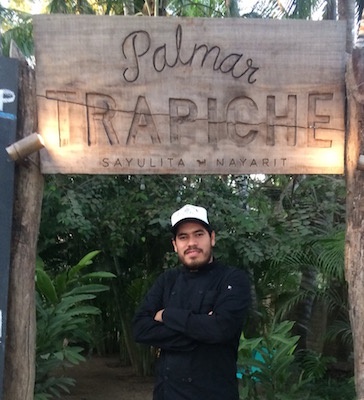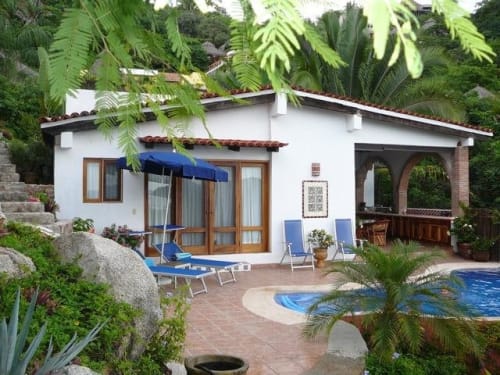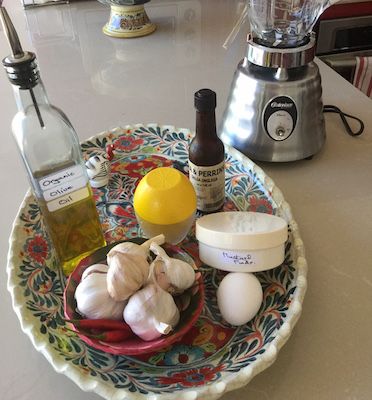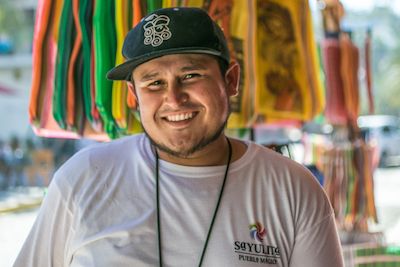SayulitaLife.com members can easily save favorites for vacation rentals, local businesses, real estate and more.
Sign In Create free accountList Your Property
Meet the Chef at Palmar Trapiche: Eduardo Guzman Alvares
 Eduardo Guzman Alvares, born and raised in Mexico City, moved to Sayulita the beginning of January to be the new head chef at Palmar Trapiche. With an impressive history of having worked at Pura Tierra in Buenos Aires, Argentina (named #50 of the top 50 restaurants in Latin America in 2016), at Alebrijes in Montevideo, Uruguay, and Sud 777 in Mexico City (named #11 of the top 50 restaurants in Latin America in 2016), he is an extremely welcome addition to Palmar Trapiche.
Eduardo Guzman Alvares, born and raised in Mexico City, moved to Sayulita the beginning of January to be the new head chef at Palmar Trapiche. With an impressive history of having worked at Pura Tierra in Buenos Aires, Argentina (named #50 of the top 50 restaurants in Latin America in 2016), at Alebrijes in Montevideo, Uruguay, and Sud 777 in Mexico City (named #11 of the top 50 restaurants in Latin America in 2016), he is an extremely welcome addition to Palmar Trapiche.
So, first off, how did your passion for cooking develop?
I was very young when I started to cook with my grandmother, but I never thought, “I am going to be a chef”. I just loved to cook and that’s all. And then one day, the thought crossed my mind that maybe I could make a living from it.
How did you get your start as a chef?
I went to a cooking school in Mexico City called CESSA Universidad, and during my last semester, I had an internship at Sud 777. After I graduated, I was offered a job in Argentina and then in Uruguay.
At Palmar Trapiche, Chef Nico Mejia, named one of the top 50 chefs by Travel + Leisure, assists with the menu. Will you tell me more about this?
Chef Nico Mejia is the best ambassador of Colima food, where our brewery is located. He supervises the three Trapiche restaurants and has an influence on the menus. (Palmar Trapiche in Sayulita, Terraza Trapiche in the main square of downtown Colima, and Jardin Trapiche at the Cerveceria de Colima, which is also the brewery house). So, the chef at any of the three restaurants might tell Nico that they are thinking about creating a new dish with such and such flavors and Nico serves as a mentor, saying yes, that will work well, or he may suggest another idea. Nico was just here in Sayulita this past weekend to assist me. Since I’m new here, he asked me how it was going with the restaurant, what I would like to change, if there were any new dishes I’d like to add, and if so, if I’d like help with that. He also tasted the dishes that I made. Currently, I will be leaving the menu the same, but will be adding dishes as specials to see what goes over well. However, my focus will most likely be seafood and local ingredients.
What made you want to cook professionally in Sayulita?
I was living in Guanajuato prior to moving to Sayulita and one day I was with some friends in Leon (just over an hour from Guanajuato). We made a sampler of craft beer and I tried some of the Trapiche beer, Cerveceria de Colima (which is served in all three Trapiche restaurants), and I fell in love with the brand. The day that Palmar Trapiche asked that I come work for them, I said, yes, definitely! I also love the tranquility of Sayulita – there’s a kind of peace here that you can’t find everywhere.
.jpg) Will you tell me about the Palmar Trapiche concept?
Will you tell me about the Palmar Trapiche concept?
In the Trapiches, as in the Cerveceria de Colima, we like things simple, but well done. We are also very proud of the products that are produced in our lands, which is why we choose to use local flavors. We focus on a fusion of two cultures – the state of Nayarit and the state of Colima – and it is reflected in every dish that we serve. You can taste both regions in each dish. The grounding is going to keep the same essence, and I will also be adding my personal knowledge and experience in the kitchen to this concept.
Are there any challenges to being a chef in Sayulita? What is harder and what is easier?
The weather here definitely makes it harder. It is very humid, which compromises the quality of the ingredients. So, you have to work with ingredients that are extremely fresh. However, it is very easy to get high quality ingredients in Sayulita that are extremely fresh – especially the seafood.
How would you describe your culinary style?
A fusion of Mexican and South American cuisine.
What are your favorite, fresh from Sayulita ingredients to use?
The tropical fruit is very, very good here – coconuts, pineapples, and bananas. The seafood, in general, is fantastic, and I also like the salt – it’s fresh and not so full of sodium.
When creating a complete meal in Sayulita, what factors do you take into consideration?
.jpg) I think there are several factors that are extremely important - the ingredients to use, how they mix and taste together, the method of cooking the protein, etc., and the presentation.
I think there are several factors that are extremely important - the ingredients to use, how they mix and taste together, the method of cooking the protein, etc., and the presentation.
Do you have a signature dish? If so, what is it and how would you describe it?
Since I just started at Palmar Trapiche I haven’t yet added a dish to the menu. I cook a lot with octopus, and it will likely be that. It will definitely be seafood with a South American / Mexican influence.
Will you share your most entertaining “kitchen disaster” story?
In Uruguay, they grill a lot, but they don’t use charcoal, only wood. You have to choose the right wood, not just any wood do. One day, we went into the restaurant and saw a bunch of wood in the main entrance, and we thought it was for us to cook. So, we started cooking with it. Then the owner came and asked for his wood, which was meant for him to build a chair. So, we had to tell him, “your chair is in the grill right now.” He was very mad, and about a month later, he finally made a joke of it, bringing a chair to give us at the restaurant.
What’s your favorite kitchen tool to use in Sayulita and why?
The grill. When you use the grill, you can make three or four different textures from the same ingredients if you know how to use it. I also like to use a microplane.
If you could recommend one other Sayulita restaurant other than yours, what would it be?
I haven’t tried all of the restaurants in Sayulita yet, but La Rustica is a very good one.
If you had to choose a last meal, what would it be?
Definitely my mother’s mole – that dish is delicious.






